keystone species
No Me No Tree - Flying Fox vs Homo Sapiens
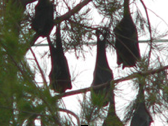 Recently I became very distressed to hear of a looming dispersal of hundreds of thousands of flying foxes at Bateman's Bay. I read the ecologist's report and Plan of Management, which strongly recommended against dispersal, then wrote a submission (on behalf of the Threatened Species Conservation Society) to Minister Greg Hunt and Eurobodalla Shire council. Since then I discovered that there are similar situations of smaller magnitude occurring here in Tweed shire, along with wherever they occur. So I wrote letters to the local papers. Following is my submission and letter to the editor. [Editor: This article, first published on 2016-06-09 was overlooked and has just now been put on front page, with a new date and thanks.]
Recently I became very distressed to hear of a looming dispersal of hundreds of thousands of flying foxes at Bateman's Bay. I read the ecologist's report and Plan of Management, which strongly recommended against dispersal, then wrote a submission (on behalf of the Threatened Species Conservation Society) to Minister Greg Hunt and Eurobodalla Shire council. Since then I discovered that there are similar situations of smaller magnitude occurring here in Tweed shire, along with wherever they occur. So I wrote letters to the local papers. Following is my submission and letter to the editor. [Editor: This article, first published on 2016-06-09 was overlooked and has just now been put on front page, with a new date and thanks.]
Importance of this Flying Fox Population
We are living in the 6th Mass Extinction of species. Australia has the world’s worst record for mammal extinctions. Here is one more example of why the list of extinct species is growing – governments are failing to adequately protect the environment.
In their nightly foraging, flying foxes fly from tree to tree, dusted with flower pollen or eject the seeds of fruit eaten, inadvertently regenerating woodlands and forests by dispersing up to 60,000 seeds each every night. Many eucalypts produce most of their nectar at night to attract these exceptional pollinators. Flying about 20-50 km a night between food trees and their camp, this keystone species maintain the genetic diversity of native trees and reforest gaps. This ecosystem service will become increasingly important to facilitate the flow of adaptive genes between trees, assist plant movement and assist the survival of many other species.
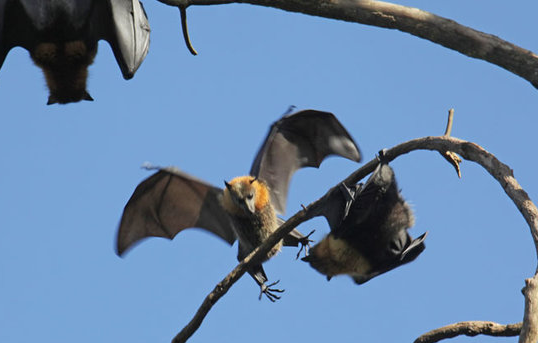
As a keystone species already in decline and vulnerable to extinction, the protection of flying foxes is tantamount. If flying foxes become extinct we are doomed. Without flying foxes we would have no more forests including World Heritage forests and hardwood forests, melaleucas, banksias, eucalypts and about 1/3rd of all fruit that relies on flying foxes to pollinate them (bananas, cashews, avocados, dates, mangoes, peaches, paw paw, durian). Scientists regard the loss of pollinators as the most serious issue facing mankind.1.
The Bateman’s Bay population of grey-headed flying foxes (GHFF) is a Matter of National Environmental Significance (MNES) i.e. there has been a population of at least 10,000 every year for 10 consecutive years. But now there are over 100,000 flying foxes at Bateman’s Bay. There are estimated to be 680,000 GHFF total.
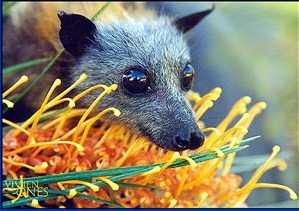
In the 2009 Recovery Plan it was noted that shooting flying foxes had diminished due to subsidies by NSW government for netting. However habitat loss is increasing and there is lack of food. For example extensive clearing on the coast for agriculture results in flying foxes losing weight, having higher mortality and lower reproduction levels. Their populations are not bouncing back. They are suffering ongoing deterioration in condition as they explore new areas e.g. inland Adelaide and Wagga Wagga. Due to food shortages they are forced to eat marginal food such as privet and green figs and are establishing satellite sites a distance from their camp.
Legal Protection
Grey-headed Flying Foxes are protected by the National Parks & Wildlife Act, 1974, Threatened Species Conservation Act, 1995, Environmental Protection & Biodiversity Conservation Act, 1999 and the International Union for the Conservation of Nature – Red List of Threatened Species.
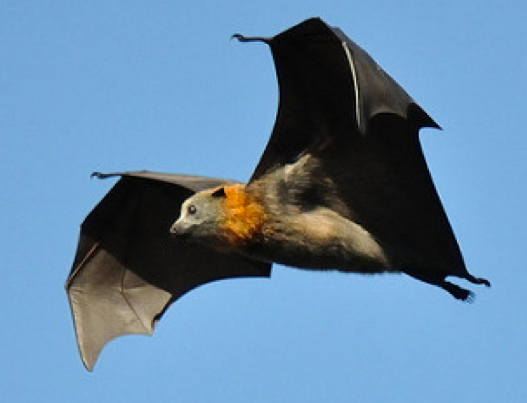
Already flying fox populations are impacted by heatstress from very hot weather (>38 degrees C), droughts, cyclones, bushfire. They don’t need the additional threat of dispersal at a time when they are starving from lack of food sources.
Why create an exception just because local residents are unwilling to live in harmony with them? If dispersal is approved, it is likely to set a dangerous precedent for people in other locations to demand dispersal of flying foxes in their area too.
Why Dispersal Should Not be Approved
There is an overwhelming number of reasons why dispersal, especially of such a large camp, should not go ahead. As you may know from the review by Roberts and Eby of 17 Flying Fox Camp dispersals4:-
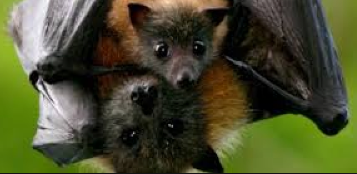
* In all cases, dispersed animals did not abandon the local area
• In 16 of the 17 cases, dispersals did not reduce the number of flying foxes in a local area
• Dispersed animals did not move far (in approx. 63% of cases the animals only moved <600m from the original site, contingent on the distribution of available vegetation). In 85% of cases, new camps were established nearby
• In all cases, it was not possible to predict where replacement camps would form
• Conflict was often not resolved. In 71% of cases conflict was still being reported either at the original site or within the local area years after the initial dispersal actions
• Repeat dispersal actions were generally required (all cases except extensive vegetation removal)
• The financial costs of all dispersal attempts were high ranging from tens of thousands of dollars for vegetation removal to hundreds of thousands for active dispersals (e.g. using noise, smoke etc)
We understand that previous attempts at Batemans Bay also were not successful, success being defined as no more conflicts, no flying fox mortalities and permanent relocation elsewhere. The following are more reasons not to disperse:-
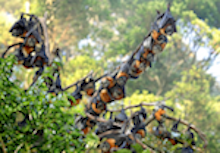
• Dispersal is highly stressful for bats and often leads to injuries or fatalities
• Very expensive (for Batemans Bay $57,800 pd for dispersal team, $1500 pd for ecologist, $5000 for management team = $6.2 million + $1 million contingency plan for the 3 stages (first year only). More for subsequent years and must cover up to 3 years
• Dispersal is planned for July-August. Approvals and preparations may take 2 months in the months of May/June. However September-October is when the bats are in late stages of pregnancy or have dependent young so very high risk of mortalities/injuries then
• 70 personnel will be required over 8 weeks, 50% of whom need to be vaccinated (most will not be locals)
• Wildlife caring groups have to struggle to help injured and orphaned bats, pay for veterinary care all without adequate financial assistance from council or government when they are already stretched thin and short of volunteers
• In the week after dispersal begins, teams need to locate injured, orphaned and dead flying foxes (p.18 of Ecological Australia’s Camp Dispersal Plan recommends that ‘no deaths or injuries’ be permitted). Trigger to stop dispersal is visibly pregnant females or with young
• More power outages will occur as bats fly around longer each morning during dispersal, becoming electrocuted on power lines
• Animal cruelty issues
• Risk of dispersed bats dying of starvation or further losing condition since they are already hungry
• Only 5% chance of success
• Dispersal disturbs residents during pre-dawn (smoke, flashing lights and noise) for the first 8 weeks initially then thereafter each time there is a dispersal. The most distressed the bats are, the noisier which in turn disturbs residents
• Bats must relocate 20km minimum during which time there is increased risk of fecal drop and disease due to stress
• Bats could relocate to unsuitable locations during dispersal for which council would be financially responsible to manage. Council could end up bankrupt if there are too many unsuitable relocations and ongoing dispersals
• As a species vulnerable to extinction in the next 25-100 years, dispersal risks their long-term survival. In fact 30% of the species died between 1989 – 1998 due to dispersals and since then their decline has been accelerated precisely due to dispersals and relocations.
• As a keystone species whose survival is required by many other species of plants and animals, their extinction would have far-reaching and devastating consequences for the entire Eurobodalla area, not just Bateman’s Bay.
FLYING FOXES COULD BECOME PERMANENT FUGITIVES AS THEY GO FROM PLACE TO PLACE, EXHAUSTED, STARVING, STRESSED, MOVED ON BY HUMANS WHOSE NEEDS ARE JUDGED MORE IMPORTANT THAN THE NEEDS OF A SPECIES ON THE TIPPING POINT OF EXTINCTION. THIS SITUATION WILL WORSTEN AS TIME GOES ON WITH INCREASING HABITAT LOSS DUE TO HUMAN OVERPOPULATION AND ENCROACHMENT INTO THEIR HABITAT.
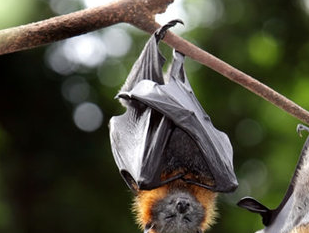
Efforts to date
We understand that Eurobodalla council has already done the following in an attempt to deal with the situation, i.e.:-
• Cleared buffers between camp and properties
• Offered subsidised services (guerneys, car and washing line covers)
• Removed 12 cocos trees,
• Slashed, mowed, pruned
• Given out informational brochures on flying foxes
Solutions
1) Education - It is critically important that residents, whether they are affected or not, clearly understand:-
a) The irreplaceable ecosystem services of flying foxes i.e. pollination of native trees (including World Heritage forests, hardwood forests, banksias, melaleucas, eucalypts etc) in the area. Flying foxes are the #1 pollinator of forests, who on their nightly foraging increase the genetic strength of plants, preventing inbreeding. Without flying foxes we would have no avocadoes, bananas, durian, cashews, dates, mangoes, peaches or paw paw. And without forests we would have less oxygen in our atmosphere.
b) Fears of disease from GHFFs must also be allayed since bats have no more diseases than any other wild animal and diseases like Lyssavirus and rabies cannot be contracted except via body fluids. It is not possible for humans to contract Hendra virus directly from flying foxes, only via infected horses.
c) A comprehensive education/advertising program must be undertaken to eradicate the common perception of bats as ‘pests’ to be culled or relocated. This should ideally include TV advertisements, articles and radio interviews so that Australians across the country become educated. Wildlife carers could be paid to take orphaned bats to schools so children can see how adorable they are and the reasons why they need our protection. I cannot overemphasise the importance of education as Australians commonly have an attitude that native animals (not just flying foxes) are ‘pests’. The prevailing public hysteria around bats needs to be defused urgently and that includes dealing with residents’ irrational fear of disease and the importance of wildlife-friendly netting for fruit trees.
2) Big Picture Explanation - Secondly, residents need to understand the reason why there are so many bats at Bateman’s Bay ie. we humans have taken away their habitat and therefore are now paying the price.
3) Tolerance - Help people learn to live in peace with flying foxes, such as:-
* Try to become quieter. Bats stress out and become noisier if people are mowing etc
* Double-glaze windows to cut down on noise.
* Park cars under cover.
* Place washing lines in the open away from trees and night-time flight paths.
* Use ear muffs at night to sleep and air purifiers for those who dislike the smell
It’s by far easier to adapt human behaviour to bats, than the other way around.
4) Repercussions - People need to seriously consider the adverse effects of no forests or native trees. What kind of future will there be for our children and grandchildren? How will they cope with less availability of certain fruits, less oxygen and more Co2 in the atmosphere from no forests?
5) Tourism Opportunities - Eco-tourism needs to be promoted so local businesses can flourish and benefit from the amazing spectacle of thousands of bats leaving their camp at sunset. This would help locals to appreciate bats for the increased tourism to their shire. Flying foxes have so many gifts to offer us if only we could get beyond the mental fixation that they are a nuisance.
6) Business Opportunities - Perhaps some enterprising person can start a business selling organic bat manure which is bound to be highly beneficial to gardens.
7) Improved gardens - Local residents can benefit from free fertiliser per compliments of the flying foxes. Some residents say gardening is impossible but bats aren’t flying around in the day. Perhaps those residents should try gardening in the daytime and not after sunset and pre-dawn when the bats are most active.
8) Deal-Breaking - Instead of spending $6-$7+ million on dispersal, council could:-
i) offer to buy back worst affected properties
ii) waive council rates for at least the period that flying foxes are present
iii) employ council officers to guerney residents’ driveways, cars etc regularly
iv) offer free air purifiers for house interiors
v) supply industrial grade ear muffs to help people sleep
vi) supply under-cover parking for those without a carport. Temporary carports can be as cheap as $150 from supercheapauto and quite durable
vii) offer the community the chance to spend this money any way they wish in lieu of dispersal e.g. new sports stadium
While all these ideas cost council money, the bottom line is they cost a lot less than dispersal without the disastrous impacts on threatened keystone species.
9) Getting to the Cause - The big-picture/long-term solution is to:-
• plant more flowering natives in bat-friendly areas (near water, in a gully) where people will never live nearby
• stop the deforestation of flowering eucalypts that flying foxes should be feeding on in winter which drive hungry flying foxes to the coast to ravage orchards
• create alternative flying fox roosting locations that include native food trees so that flying foxes don’t rely on orchards and therefore impinge upon humans. Non-residential urban areas such as parklands, golf courses and even cemeteries can be planted with a range of native trees that provide fruit (small-leaved figs) and nectar (eucalypts and melaleucas). This would provide feeding sites away from residential areas and corridors for them to travel between remnant forests. If these natural food sources are available when commercial fruit trees are bearing fruit, flying foxes are less likely to become a problem.
• a camp may be encouraged to move (which is not the same as forced relocation) and can be done by planting roost trees further away from houses. Surveys of flying-fox camps in New South Wales have shown that a distance of as little as 100 metres from neighbouring houses can be enough to reduce the noise level of a flying-fox camp to an acceptable level.
• Remove the lower branches of trees and clearing the understorey, to create a buffer between roosting animals and surrounding residents. Such actions would need to be undertaken carefully, preferably in conjunction with the creation of suitable habitat elsewhere, and subject to a monitoring program. Further research needs to be done into the factors influencing the establishment and persistence of flying fox camps.2.
• Low, dense trees and shrubs planted around fence lines also form a barrier that flying-foxes are unlikely to roost in3.
• Incorporate a buffer zone between the building and roost trees that ideally should not be paved or made of concrete in order to reduce mess problems. Plant low growing fragrant shrubs in this zone to minimise future encroachment by the animals into the site and reduce odour problems. Planting tall trees will only eventually bring the animals closer in to the development.
• Worst case scenario if everything else fails, dangle electric wire from the trees which the bats touch and it gives them a small electric shock, and then they go away. While it's only a small shock, still it's better than being killed.
10) All About Timing - The camp will reduce in size in the next few weeks or months so people could wait patiently, most of the flying foxes will leave when the flowering season of spotted gum, red bloodwood, and blackbutt begins to decline. Or at the very least wait till early February when juveniles will be independent, recommended by Ecologic Australia. Success is more likely if dispersal takes place when the camp is smaller and outside bats’ sensitive life cycles.
Conclusion
All affected residents at Batemans Bay moved into their houses knowing full-well that flying foxes lived nearby since they have had at least 10,000 flying foxes per year for the last ten years. It is reasonable to expect that the flying foxes would breed and expand their population (as with human populations).
For governments to bend over backwards and break important rules and regulations that are in place to protect our environment and especially threatened species to appease people who lack the tolerance, compassion and understanding of bats is a grave error, one that we will pay for long into the future should the bats become extinct.
The Threatened Species Conservation Society Inc. sincerely hopes that the Eurobodalla council and the Federal Government will at least try a bit harder to solve this problem instead of going down the route of dispersal which is guaranteed to fail and be hugely expensive, for the sake of our little forest-makers.
References
1. https://www.youtube.com/watch?v=eqsXc_aefKI
2. www.jcu.edu.au/rainforest/issues/ITFL_flyingfox.pdf
3. http://www.derm.qld.gov.au/wildlife-ecosystems/wildlife/living_with_wildlife/flyingfoxes/
4. http://www.esc.nsw.gov.au/inside-council/council/meetings/2016/may/ordinary-council-meeting-10-may-2016/Batemans-Bay-Flying-fox-Camp-Dispersal-Plan.pdf
Letter to the Editor
Dear Editor
Conflict between flying foxes and humans in our shire is so disconcerting. Humans have destroyed 75% of pre-colonial forests for logging, mining, livestock grazing, industries, cities and housing. We continue to take from the land whatever resources we need to make ourselves comfortable (computers, TVs, cars, refrigerators, mobile phones, iPads etc).
But when the flying foxes are too close to our schools and homes, screeching and squabbling all day with a smell we dislike, we scream ‘they have to go’! But where? We have taken away their habitat, their food sources and now they are becoming permanent fugitives as they go from place to place, exhausted, starving, stressed, moved on by humans whose needs are judged more important than the needs of a species on the tipping point of extinction. This situation will worsten as time goes on with increasing habitat loss due to human overpopulation and encroachment onto their land.
Flying fox populations have declined 95% in the last century and 30% since 1988 and are vulnerable to extinction. Their ecosystem services of night-time pollination is without compare. Every night they fly up to 50km dispersing approximately 60,000 seeds each. What does it mean if they become extinct? Simply this – no more World Heritage forests, hardwood forests, melaleucas, banksias, eucalypts and about a third of all fruit (including bananas, avocadoes, mangoes, peaches, pawpaw, cashews). And fewer trees mean less oxygen to breathe.
Our preoccupation with creature comforts is trivial in comparison. Shouldn’t we be incredibly grateful to this keystone species whose existence is critically important for so many other species including ourselves? Shouldn’t we be a bit more tolerant? From a bat’s perspective we are the ones who are stinky, filthy, noisy pests!
They are not the one with outrageously loud ‘music’ festivals and doof music blaring from their noisy cars and radios! They are not the one brushcutting, mowing on tractors, bulldozers and earthmoving equipment tearing up our habitat! Nor are they the ones stinking up the environment with their cigarettes, chemical sprays, chimney smoke and hazard reduction burns! Flying foxes are not pouring their feces and cow sewage into the ocean. No, it is us who are the pests. Additionally they are native whereas we are ferals having just arrived in this land 230 years ago.
Humans have had it good for too long. If we can’t live in harmony with other species in an ecocentric vs anthropocentric way, we too will head for extinction.
If aliens were watching us they would probably think we were the stupidest creature on the planet. Either that or that psychopaths were running the country.
Calls to 'Bomb' and 'Cull' Flying Foxes
 Why do humans think they own the planet? Are we as a species so ignorant of basic ecology that we would continuously deprive the very creatures who make the forest of anywhere to roost? It is frightening to watch this attitude balloon into what could potentially be not only suicidal but ecocidal.
Why do humans think they own the planet? Are we as a species so ignorant of basic ecology that we would continuously deprive the very creatures who make the forest of anywhere to roost? It is frightening to watch this attitude balloon into what could potentially be not only suicidal but ecocidal.
After Hendra virus was found in a Queensland dog recently, and a total of 14 HeV infected horses died or were put down since June 20 this year, Queensland opposition Liberal National Party (LNP) leader Campbell Newman suggests smoke bombs and choppers to evict urban bat colonies then the roosting trees should be cut down. Failing what he refers to as 'humane relocation of colonies,' he recommends that the bats be 'culled.'
Premier Anna Bligh issued warnings to the media from scientists that moving bat colonies out of populated areas would increase their stress levels and could worsen the spike in Hendra virus cases. She announced that Qld and NSW would increase Hendra virus research funding by $6 million over the next three years.
Charters Towers Mayor Ben Callcott went even further. He is quoted as saying that he backed the use of helicopters but said culling rather than smoke-bombing was the real solution. He said "Bats are the same as dinosaurs, we have got no dinosaurs and we should not have any bats either."
But dogs, cats, rats, mice, brush-tailed possums, bandicoots, hares, carpet pythons and any blood sucking insects such as ticks, mosquitoes and march flies also carry HeV, should we ‘cull’ them all too?
Do Flying Foxes Cause HeV in Horses?
The link between flying foxes and horse hendra is not definitive. AAHL research shows that HeV cannot be transmitted directly to horses from flying foxes (from urine/faeces/saliva). Aust Veterinary Journal Vol 76 No 12, says: “It is possible to transmit HeV from cats to horses. Transmission from Pt. poliocephalus to horses could not be proven and neither could transmission from horses to cats ….. the virus is not highly contagious.”
Not enough is known about how Hendra circulates in the environment. Other possible infection routes need to be investigated e.g. exposure to other species or food contamination from cat/rat/mouse faeces. It's possible that horses and flying foxes could be infected from a third source.
There is no threat to humans as long as bats are not touched. Hendra does not spread easily and is rarely transferred from horses to humans.
Why do we Need Flying Foxes?
Flying foxes are keystone species. Humans could never plant forests as quickly and effectively as bats which disperse up to 60,000 seeds from night-flowering species each per night. Our World Heritage forests, endangered ecological communities, woodlands, forest ecosystems (along with the biodiversity they contain) and fruits like bananas, paw paws, durians, cashews (including hardwoods, banksias, eucalypts and melaleucas) could not survive without flying foxes.
For Mayor Callcott to be inducing public hysteria with his media statements is irresponsible and could endanger flying foxes. Two species are already federally threatened. Their habitat has been seriously eroded by human encroachment and their populations are being hounded from roosting spot to roosting spot. Humans simply must learn to cohabit peacefully and respectfully with these forest makers or we will have no more forests.
Threats of Bats to Humans Compared with Threats of Humans to Humans
According to the Bureau of statistics causes of death 2008 updated 31/03/2010, 26 people died falling from ladders, 226 people died in motorcycle accidents, 182 deaths due to obesity, and 1402 total transport accidents and from other sources around 14000 die from smoking related illness, 10000 from alcohol related illnesses. 29000 Australians are know to be HIV positive, do we quarentine these people to protect the spread of infection? Is it our innate features that allow us to accept threats by fellow humans and at the same time rise to eliminate threats from wildlife? Since the early 1970's there have been 26 fatality’s caused by crocodiles. Whenever a crocodile shows it's head near an urban area there is a rise to cull crocodiles. The same reaction is being seen towards flying foxes. Are those in society who cry out to remove potential threats from wildlife to the pinnacle of human evolution, which will ensure no other species will threaten our continued rise?
While research is totally focussed on flying-foxes the real culprit could remain unidentified. We need good investigative science to solve the problem, not hysteric, knee-jerk reactions from bureaucrats like Mayor Callcott.
Lastly, we can live without horses but we cannot live without flying foxes, so let's get our priorities straight.
This year, 2011, is the International Year of the Bat, let's get this one right for a change! www.bats.org.au
*****
http://www.couriermail.com.au/news/queensland/lnp-wants-to-chase-bats-out-of-urban-areas-with-smokes-bombs-choppers/story-e6freoof-1226102670395
Informed comments found at
http://www.abc.net.au/environment/articles/2011/07/18/3270559.htm

Recent comments